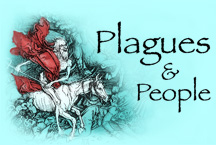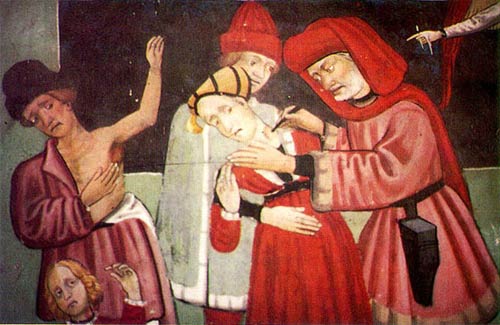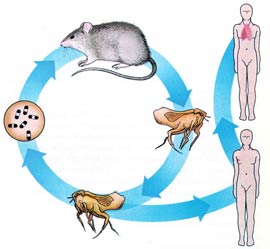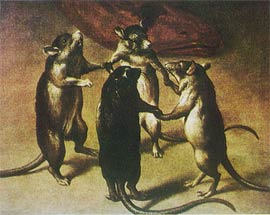HISTORY 135F

Infectious and
Epidemic Disease in History
Department of History
University of California, Irvine
Instructor: Dr. Barbara J. Becker
HISTORY 135F

Infectious and
Epidemic Disease in History
Department of History
University of California, Irvine
Instructor: Dr. Barbara J. Becker
 In 1347, the plague that became known as the Black Death moved into Europe from Asia traveling quickly along well-trafficked trade routes. In fact, the deadly disease had reached the Crimea on the northern coast of the Black Sea by September 1345. Italian merchants had a number of trading colonies there. One story tells of a seige of the city of Kaffa by Janibeg Khan whose army had been stricken by plague. The Khan ordered bodies of the plague victims to be catapulted into the city walls. Genoese merchants who escaped the city returned home carrying the disease with them. Reports reached Europe in 1346 that India had been depopulated and that Tartary, Mesopotamia, Syria and Armenia were covered with dead bodies. In some areas rumor had it that no one had been left alive. Later, people would recall other portents of the coming plague:
Illuminated manuscript (c. 1410) from St. Augustine's City of God (MS 45-65-1 fo. 115v.) in the Philadelphia Museum of Art's Philip S. Collins Collection. The plague stopped first near Consantinople in 1347. By October it reached Messina, Sicily. Ten years after the fact, Michael of Piazza, a Franciscan friar recorded that the disease arrived in Messina on twelve Genoese galleys. Plague broke out within days of the ships' arrival. Citizens turned on the sailors and forced them and their ships to leave the port. But it was too late. As illness spread and deaths increased, frightened Messinese fled into the countryside carrying the disease with them. When refugees began arriving in the city of Catania, they were welcomed until the residents realized what was happening. Officials in Catania instituted strict control over the movement of people. The Messinese viewed the Catanians as callous and evil while the Catanians viewed their actions as a matter of simple self-preservation. Michael of Piazza recounted a wondrous tale of the archbishop of Catania's failed attempt to rid Messina of the plague through divine intervention. It is reminiscent of an account of St. Francis of Assisi's (1181-1226) fabled expulsion of demons from the city of Arezzo that would have been familiar to his readers:
The Expulsion of the Devils from Arezzo (1297-1299) by Giotto di Bondone (1266-1337). According to Michael of Piazza, relics of St. Agatha, the patron saint of Catania, were dipped in water by the archbishop. He carried the water to Messina, but when he arrived:
From Sicily, the plague spread to Tunis, Corsica, Sardinia, the Balearics, the Iberian peninsula and to southern Italy, arriving in Genoa and Venice around January 1348. |
More than you ever wanted to know about bubonic plague.... |
|
|
Identified in 1894 by Swiss-born French bacteriologist, Alexandre Yersin
(1863-1943)
Three natural varieties, all toxic to man:
· medievalis
· antiqua
|
How Yersinia pestis bacilli cause illness:
Lifespan of Yersinia pestis bacilli outside of living host:
|
|
Three forms of the disease: |
|
|
|
|
|
|
|
|
|
|
||
|
|
|
|
|
||
| 1-6 days of incubation
Abrupt onset with
|
1-3 days of incubation
Abrupt onset with
|
Virtually no incubation period
Abrupt onset Death |
1-2 days after onset:
|
1-3 days after onset:
|
|

Man with bubo in armpit. Physician lancing a bubo on woman's neck. |
||
3 days after onset:
4-5 days after onset:
[half of plague victims had already died by this stage, so those who lasted this long had a better than even chance of survival!]8-10 days after onset:
|
||
Primary Plague Bacillus Vector:
|
|

|
|
Primary flea vector: burrowing wild
rodents
Wild rodent life cycle:
|

Black rat (Rattus rattus)
|
Why? Searching for explanations.... |
Why did some people fall ill and not others?
Why did some victims recover while others died? Why did some die suddenly even though they did not show any symptoms? Why now? Why here? |
Some modern explanations based on archaeological, historical, and physiological evidence:
|
Why US? To learn about some contemporary explanations, see the documents in this week's readings listed below. |
|
 |
| Go to: |
|
|